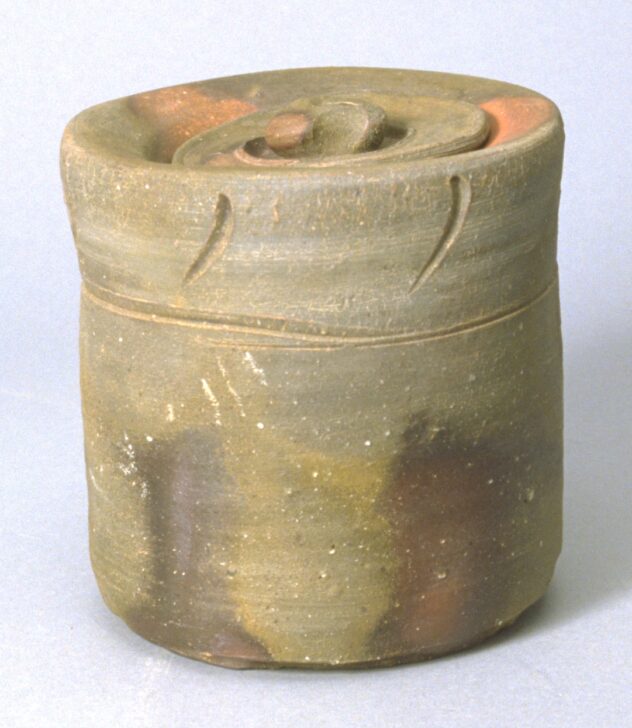Bizen ware water jar with lid (mizusashi)
Kaneshige Tôyô

Description
Like Shigaraki ware, Bizen is an unglazed stoneware fired in a wood-burning kiln—but differences in the local clay yield entirely different results. Bizen clay contains a high percentage of iron; it yields a hard, smooth surface that holds sharply incised decor. As the light pine ash drifts through the kiln, it falls on the clay, creating a "sesame seed" effect. Seaweed or salt-soaked straw rope is often wrapped around the pot to leave patterned traces.
The Bizen kilns have been in operation since the sixth century, but by early modern times, they were in steep decline. Kaneshige Tôyô single-handedly led a revival of Momoyama wares. His work can be remarkably faithful to Momoyama prototypes, as in this water jar, or subtly modern, as in the flower vase with its angular contours. For his accomplishments in restoring Bizen ware to its long-lost fame, Kaneshige was named a "Living National Treasure" by the Japanese government.
Exhibited in "Japanese Costumes & Ceramics, Past & Present," October 2001-February 2002. Maribeth Graybill, Senior Curator of Asian Art
---
Bizen and Shigaraki wares represent a tradition, long prized in Japan, of unglazed stoneware fired in a wood-burning kiln. Bizen clay contains a high percentage of iron, which produces a hard, smooth surface that holds sharply incised décor; the sesame seed effect seen here is created by the pine ash that falls on the clay as it drifts through the kiln. The Bizen kilns have been in operation since the sixth century, and in the Momoyama period (1583–1615), the rustic, earthy clay tones of the wares produced in them were highly valued by tea practitioners. By the early nineteenth century, however, the quality of Bizen wares was in steep decline. Kaneshige single-handedly revived this sixteenth-century ceramic tradition, while bringing to bear on it a twentieth-century aesthetic. His work is characterized by its bold clay construction and free, playful application of fire patterns.
(Turning Point exhibition, Spring 2010)
Subject Matter:
The Bizen kilns have been in operation since the sixth century, but by early modern times, they were in steep decline. Kaneshige Tôyô single-handedly led a revival of Momoyama wares. His work can be remarkably faithful to Momoyama prototypes, as in this water jar, or subtly modern. A water jar like this would have been used for tea ceremony.
For his accomplishments in restoring Bizen ware to its long-lost fame, Kaneshige was named a "Living National Treasure" by the Japanese government.
Physical Description:
This is an unglazed stoneware bizen jar fired in a wood-burning kiln.
It has a hard, smooth surface with decorative incisions near the top of the jar. The lower portion has effect of color gradation of reds and browns. The lid seems to dip into the jar, and has a know handle. The entire piece is not perfectly formed, but has an organic aesthetic.
Usage Rights:
If you are interested in using an image for a publication, please visit https://umma.umich.edu/request-image/ for more information and to fill out the online Image Rights and Reproductions Request Form.